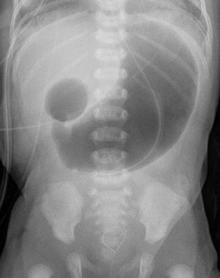Duodenal atresia
| Classification according to ICD-10 | |
|---|---|
| Q41.0 | Congenital absence, atresia and stenosis of the duodenum |
| ICD-10 online (WHO version 2019) | |
The duodenal atresia , also known as Duodenojejunale atresia called, is a congenital to the atresia associated developmental disorder in which the lumen of the duodenum is not continuous. This is either due to a lack of a short or a longer part of the intestine (a real atresia ), a membrane in the intestinal lumen or a malposition of the pancreas (annular malposition of the pancreas pancreas annulare ), in which case usually only a duodenal obstruction is present, see. Duodenal stenosis . The lack of patency causes the stomach and intestines to widen before birth before the atresia and the rest of the intestine remains small because the swallowed amniotic fluid does not reach this part of the intestine. There is also polyhydramnios .
frequency
The frequency of occurrence is 1 in 7,000. Other malformations are present in around half of those affected . Duodenal atresia in pancreas annulare is found more frequently in children with trisomy 21 , around 20%, and heart defects in a further 20% .
Classification
The following classification is common:
- Type I (duodenal diaphragm) with a membrane that closes the lumen and normal muscle wall
- Type II (cord-shaped duodenal atresia) with a brief interruption by a cord of connective tissue
- Type III (complete duodenal atresia) with complete separation of the two ends of the duodenum
A modified classification can be found under intestinal atresia # classification .
Symptoms
The infants vomit because the food cannot pass through. Other possible symptoms are bilious vomiting, sunken lower abdomen, clear (gastric juice) vomiting or a bulging upper abdomen.
Diagnosis
During ultrasound examinations (prenatally as part of prenatal diagnosis ), duodenal atresia is evident due to the so-called " double-bubble phenomenon ": the unborn child's stomach is filled with fluid (first bubble) and the duodenum (duodenum) also has fluid up (second bubble / "Bubble"). Because of this, lying side by side, the ultrasound image shows a double bubble (so-called "double bubble" ).
The same phenomenon can also be seen after birth through an X-ray examination. The fact that the upper gastrointestinal tract fills with air after birth creates an air bubble in the stomach and one in the duodenum. The rest of the intestinal tract is evacuated.
Differential diagnostics
To be delimited is u. a. a pyloric atresia .
therapy
Therapy takes place after birth ( postnatal ) , as soon as possible, surgically. Until then, a gastric tube is inserted to give the secretion ( saliva , gastric juice , small intestinal juice ), which cannot flow into the further small intestine, an outlet to the outside. During the operation, depending on the cause of the atresia, either the intestine is opened and the membrane is severed, the intestinal parts are sewn together or, if the size differences between the upper and lower parts are too large, an enterostoma is temporarily created, which is then removed again later. After the operation, due to massive widening of the duodenum and the associated passage disruptions, it can take a long time before a complete diet can be built up through the mouth.
See also
Individual evidence
- ↑ a b Duodenal atresia. In: Orphanet (Rare Disease Database).
- ↑ Sonography Figure 1 ( Memento from December 21, 2012 in the Internet Archive )
- ↑ Sonography Figure 2

